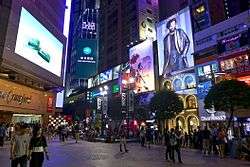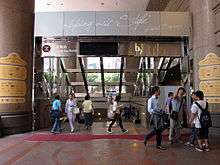Russell Street, Hong Kong

Russell Street (Chinese: 羅素街) in Causeway Bay, Hong Kong Island, is a commercial shopping street in Hong Kong. In 2014, it was noted as the most expensive luxury street in the world.[1]
Russell Street is an east-west running street with two sections. It starts from Lee Garden Road, split by Matheson Street and Percival Street, and ends in Canal Road East. Russell Street is one of the most crowded streets in Hong Kong. The eastern section from (Lee Garden Road to Percival Street) was renovated and reopened as a full-time pedestrian street in April 7, 2000.[2] It was the first pedestrian street in Hong Kong. The remaining section, from Matheson Street to Canal Road East, was also added to the scheme as a traffic-calming street later.[3]
Name
Russell Street is named after James Russell a colonial official and Chief Justice of the Supreme Court of Hong Kong from 1888 to 1892. Russell died at an early age of 50 in 1893. Following his death, the Hong Kong Daily News described Russell as: "one of the most hard working officials that the Hong Kong Civil Service has ever possessed, and with his industry were united great natural shrewdness and common sense."[4]
History
Russell Street used to be a traditional Chinese wet market where hawkers sold vegetables, fruits, meats and groceries. Dai pai dong (cooked-food stores) could also be found along the street. Due to the lack of hygiene and sanitation knowledge at that time, mice infestation was very serious in there—people even called Russell Street the "Mouse Street".[5] The Jian family, in 1905, founded The Nanyang Brothers' Tobacco Co., based in Russell Street. Due to the intense rivalry with the monopoly, British American Tobacco company, the Jian family declared bankruptcy and closed the factory in 1908.[6] In the 1920s, Hong Kong Tramways built a tram depot by Russell Street, mainly for tram repair and parking. As the demand for tram service grew, the old Russell Street tram depot could no longer park all the trams Hong Kong Tramways owned. The company decided to expand the Russell Street depot, and at the same time built a temporary tram depot in North Point to ease tram parking problem. In 1951, Hong Kong Tramways finished the renovation of Russell Street depot, renamed it as Sharp Street depot. The North Point temporary tram depot was then closed.[7] Not long after the expansion of the Russell Street tram depot, the Tramway workers resented Hong Kong Tramways for unjustifiable dismissal and break of employment contract, which eventually caused a labor dispute in 1952. In 1989, Lockhart Road market reconstruction completed. Hawkers and Dai Pai Dong on Russell Street all moved into the new Lockhart Road market. The Sharp Street depot (formerly Russell Street depot) was shut down and demolished. All trams were moved to Sai Wan Ho and Whitty Street depot. The site of Russell Street was then reconstructed into Times Square.
1952 Labor dispute
The tramways workers were initially seeking to end the new Condition of Services introduced by the Hong Kong Tramways. But the political elements eventually changed the focus to disputes between the management and unions with political background. In 1951, the Hong Kong government proposed that most of the workers' variable living allowance paid by their employers should be included as part of the basic wage. The Hong Kong Tramways then launched a new Condition of Services along with the new wage plan, stating that other than allowances, dismissal and retirement compensations would also be considered as part of the basic wage. Most of the workers were opposed to the new Condition of Services. The Hong Kong Tramway Workers' Union (HKTWU) even asked for mediation from the Labor Department with Hong Kong Tramways. The HKTWU, a member of the left-wing Hong Kong Federation of Trade Unions. After they announced their intention to mediate with Hong Kong Tramways through the Labour department, left-wing organizations and unions actively showed support to them. Considering the political background of HKTWU, the Hong Kong Tramways refused to attend mediation with HKTWU. Instead, they held a meeting with workers representatives, given that workers could not claim to be representatives of the HKTWU. These meetings went on for several months, and Hong Kong Tramways at last agreed to change mandatory participation in the new Condition of Services to voluntary-based participation. The Tramway workers gained success in the negotiation with Hong Kong Tramways, but HKTWU then requested recognition from Hong Kong Tramways, which turned the dispute into political means. The Hong Kong Tramways recognized another non-political Tramway workers' union, but refused to recognize the HKTWU, which led to discontents among HKTWU members and other left-wing organizations and unions. The conflict became more intense after three tramway workers were dismissed on April 20, 1952. The HKTWU met with Hong Kong Tramways, asking to restore the three workers' position. Lots of workers gathered outside the Russell Street tram depot, waiting for the result of the meeting. The meeting continued for two days. Two of the three workers were eventually reinstated.[8]
World's highest retail rents
Recently, store frontage on this street, was named the most expensive in the world at HK$21,700 or USD $2,800 per square foot.[9]
Features
Nearby the street, there are Times Square, a video wall, a MTR station, a cinema, many famous shops, taxi station.
Transportation

MTR
The south concourse of Causeway Bay Station is located in the Time Square basement. This concourse can only lead to Exit A, the entrance of Time Square at the intersection of Russell street and Matheson Street.[10]
Tram
Route 105, from Kennedy Town to Happy Valley Terminus, stops at the intersection of Percival Street and Foo Ming Street, which is only one block away from Russell street. This route is operated by Hong Kong Tramways.[11] Tram fare is HKD $2.30 per adult.
Bus
Canal Road East stop is located under Canal road flyover, right across Russel Street. The Kowloon Motor Bus, Citybus, and New World First Bus run 15 routes via this stop.
- Routes that stop at Canal Road East
- Kowloon Motor Bus[12]
| Route | Terminals | ||
|---|---|---|---|
| 108 | Braemar Hill Public Transport Interchange | → | Kai Yip |
| 116 | Quarry Bay (Yau Man Street) | → | Tsz Wan Shan (Central) |
| 112 | North Point (Pak Fuk Road) | → | So Uk Bus Terminus |
| N112 | Shau Kei Wan | → | Mei Foo Public Transport Interchange |
- City Bus[13]
| Route | Terminals | ||
|---|---|---|---|
| 72 | Causeway Bay (Moreton Terrace) Bus Terminus | → | Wah Kwai Estate Public Transport Interchange |
| 72A | Causeway Bay (Moreton Terrace) Bus Terminus | → | Sham Wan Road Public Transport Terminus |
| N72 | Quarry Bay (Hoi Chak Street) | → | Wah Kwai Estate Public Transport Interchange |
| 77 | Shau Kei Wan | → | Tin Wan Bus Terminus |
| 96 | Causeway Bay (Moreton Terrace) Bus Terminus | → | Lei Tung Estate Bus Terminus |
| 592 | Causeway Bay (Moreton Terrace) Bus Terminus | → | South Horizons Public Transport Interchange |
- New World First Bus
| Route | Terminals | ||
|---|---|---|---|
| 15B | Wan Chai (Convention Centre) | → | The Peak Public Transport Terminus |
| 38 | North Point Bus Terminus | → | Chi Fu |
| 42 | North Point Bus Terminus | → | Wah Fu (South) Bus Terminus |
| 42C | North Point Bus Terminus | → | Cyberport Public Transport Interchange |
| 65 | North Point Bus Terminus | → | Stanley Bus Terminus |
| 116 | Quarry Bay (Yau Man Street) | → | Tsz Wan Shan (Central) |
| 112 | North Point (Pak Fuk Road) | → | So Uk Bus Terminus |
| N112 | Shau Kei Wan | → | Mei Foo Public Transport Interchange |
See also
References
- ↑ Erwan Rambourg, The Bling Dynasty, Wiley 2014, p.11
- ↑ "Russell Street - the first pedestrian scheme comes true". www.td.gov.hk. Hong Kong transport department. Retrieved 19 October 2015.
- ↑ "Pedestrian Schemes for Causeway Bay". Hong Kong transport department. Hong Kong transport department. Retrieved 19 October 2015.
- ↑ Daily Press, James Russell obituary, published: 4 September 1893
- ↑ "Hong Kong stories 1-5 RTHK". youtube. RTHK. Retrieved 29 October 2015.
- ↑ "簡氏兄弟實業救國". Vision Times. Vision Times. Retrieved 31 October 2015.
- ↑ "Hong Kong Tramways-- Our story". Hong Kong Tramways. Hong Kong Tramways. Retrieved 29 October 2015.
- ↑ Lam, Wai Man. "Understanding the Political Culture of Hong Kong: The Paradox of Activism and Depoliticization". Google Books. An East Gate Book. Retrieved 31 October 2015.
- ↑ "Russell Street in Hong Kong Surpasses Fifth Avenue in New York For World's Most Expensive Rent". iRealtyTimes.com. September 21, 2012. Retrieved February 23, 2013.
- ↑ "Causeway Bay Station layout" (PDF). MTR Hong Kong. MTR Hong Kong. Retrieved 19 October 2015.
- ↑ "Plan your ride". Hong Kong Tramways. Hong Kong Tramways. Retrieved 19 October 2015.
- ↑ "Bus stop search". The Kowloon Motor Bus Co. The Kowloon Motor Bus Co. Retrieved 19 October 2015.
- ↑ "Route and services". City bus and NWFB. City bus and NWFB. Retrieved 31 October 2015.
External links
| Wikimedia Commons has media related to Russell Street, Hong Kong. |
| Look up 羅, 素, or 街 in Wiktionary, the free dictionary. |
- Russell street,Hong Kong on Google map
- Roads in Hong Kong named after British and colonial officials
- Back to the old depot
- The Hong Kong wet markets (Traditional Chinese)
- Hong Kong history III: Russell Street tram depot (Traditional chinese)
- Big Business in China: Sino-foreign Rivalry in the Cigarette Industry, 1890-1930
- Golden-Silk Smoke: A History of Tobacco in China, 1550–2010
- Biographical Dictionary of Republican China, Volume 3
Coordinates: 22°16′44″N 114°10′58″E / 22.27889°N 114.18269°E